The AMD Radeon R9 290X Review
by Ryan Smith on October 24, 2013 12:01 AM EST- Posted in
- GPUs
- AMD
- Radeon
- Hawaii
- Radeon 200
Bioshock Infinite
Bioshock Infinite is Irrational Games’ latest entry in the Bioshock franchise. Though it’s based on Unreal Engine 3 – making it our obligatory UE3 game – Irrational had added a number of effects that make the game rather GPU-intensive on its highest settings. As an added bonus it includes a built-in benchmark composed of several scenes, a rarity for UE3 engine games, so we can easily get a good representation of what Bioshock’s performance is like.
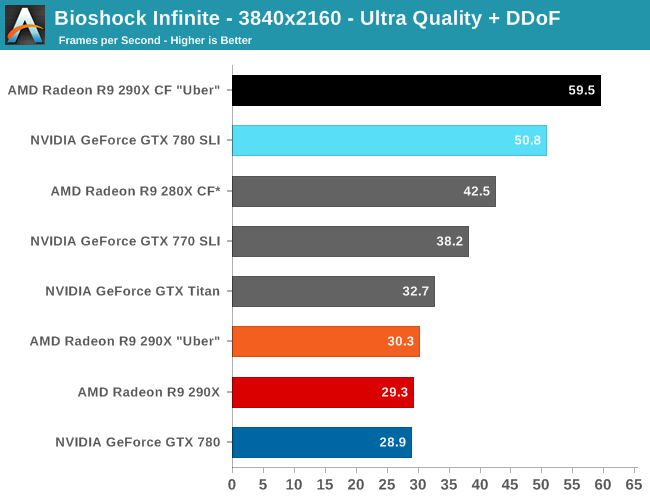

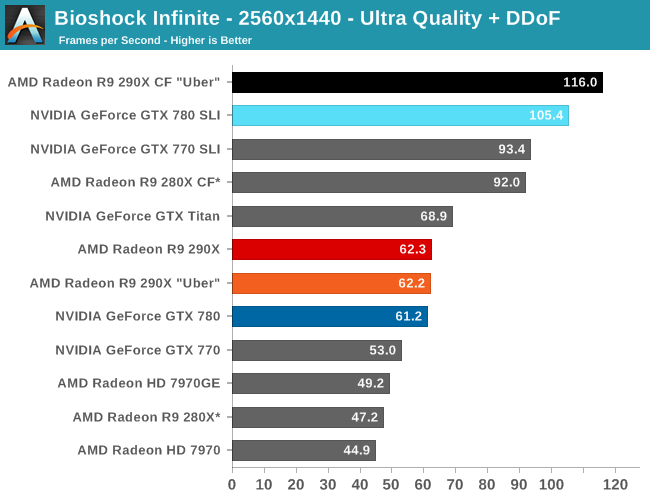
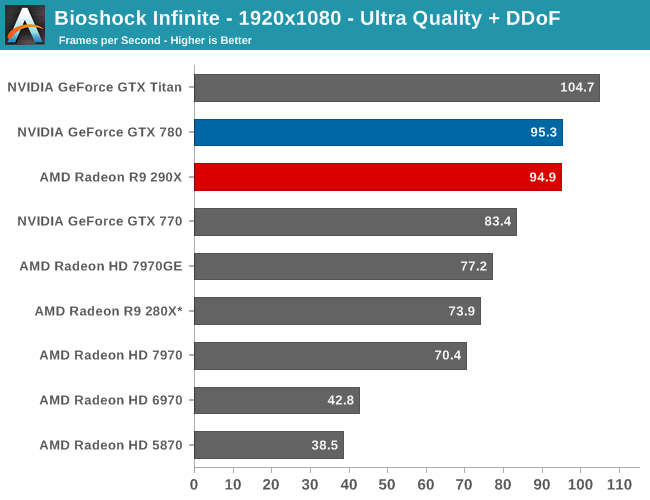
The first of the games AMD allowed us to publish results for, Bioshock is actually a straight up brawl between the 290X and the GTX 780 at 2560. The 290X’s performance advantage here is just 2%, much smaller than the earlier leads it enjoyed and essentially leaving the two cards tied, which also makes this one of the few games that 290X can’t match GTX Titan. At 2560 everything 290X/GTX 780 class or better can beat 60fps despite the heavy computational load of the depth of field effect, so for AMD 290X is the first single-GPU card from them that can pull this off.
Meanwhile at 4K things end up being rather split depending on the resolution we’re looking at. At Ultra quality the 290X and GTX 780 are again tied, but neither is above 30fps. Drop down to Medium quality however and we get framerates above 60fps again, while at the same time the 290X finally pulls away from the GTX 780, beating it by 14% and even edging out GTX Titan. Like so many games we’re looking at today the loss in quality cannot justify the higher resolution, in our opinion, but it presents another scenario where 290X demonstrates superior 4K performance.
For no-compromises 4K gaming we once again turn our gaze towards the 290X CF and GTX 780 SLI, which has AMD doing very well for themselves. While AMD and NVIDIA are nearly tied at the single GPU level – keep in mind we’re in uber mode for CF, so the uber 290X has a slight performance edge in single GPU mode – with multiple GPUs in play AMD sees better scaling from AFR and consequently better overall performance. At 95% the 290X achieves a nearly perfect scaling factor here, while the GTX 780 SLI achieves only 65%. Curiously this is better for AMD and worse for NVIDIA than the scaling factors we see at 2560, which are 86% and 72% respectively.
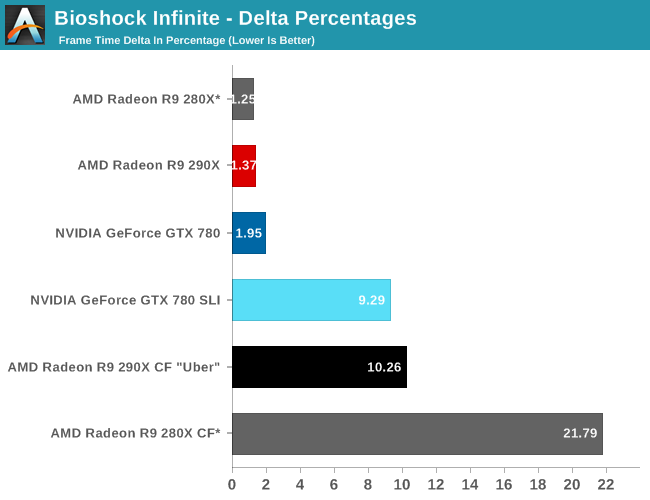

Moving on to our FCAT measurements, it’s interesting to see just how greatly improved the frame pacing is for the 290X versus the 280X, even with the frame pacing fixes in for the 280X. Whereas the 280X has deltas in excess of 21%, the 290X brings those deltas down to 10%, better than halving the variance in this game. Consequently the frame time consistency we’re seeing goes from being acceptable but measurably worse than NVIDIA’s consistency to essentially equal. In fact 10% is outright stunning for a multi-GPU setup, as we rarely achieve frame rates this consistent on those setups.
Finally for 4K gaming our variance increases a bit, but not immensely so. Despite the heavier rendering workload and greater demands on moving these large frames around, the delta percentages keep to 13%.


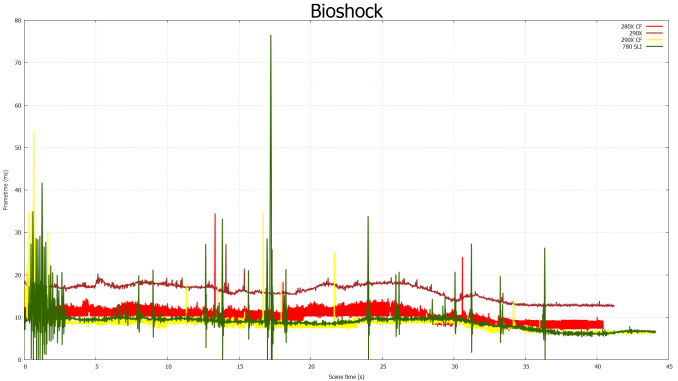









396 Comments
View All Comments
pattycake0147 - Friday, October 25, 2013 - link
Nope piroroadkill is spot on with speaking his opinion. Anand continually asks for reader feedback, and he's doing just that.The rate at which this article is being finished is piss poor. Ryan said it would be finished in the morning the day of posting which meant in the next 12 hr or so. The main explanatory pages took about 24 hr to be completely fleshed out, and the graphs still don't have any text explaining the trends in performance. I actually value the author's commentary more than the graphs, and looking through a review which is incomplete over 36 hr after posting is much below Anandtech standards.
I hate to bring it up because I like reading the vast majority of content on Anandtech regardless of market or complany, but I firmly believe piroroadkill is correct in saying that a new Apple product would have had a complete and thorough review shortly after NDA was lifted.
HisDivineOrder - Friday, October 25, 2013 - link
He had three R9 290X's in one system. Crossing his chest, he took out his third and slid its PCIe into the test bed. Immediately, the room began to darken and a voice spoketh, "You dare install THREE R9 290X's into one system! You hath incurred the wrath of The Fixer, demon lord of the 9.5th circle of hell! Prepare for the doooooom!"Then the system erupted into flames, exploding outward with rapid napalm-like flames that sent him screaming out the door. Within seconds, the entire building was burning and within minutes there was nothing left but ashes and regrets.
Ever since, he has been locked away in a mental health ward, scribbling on a notepad, "Crossfire," over and over. Some say on the darkest nights, he even dares to whisper a single phrase, "Three-way."
B3an - Saturday, October 26, 2013 - link
LOL!Ryan Smith - Monday, October 28, 2013 - link
Hahaha!Thanks man, I needed that.
yacoub35 - Friday, October 25, 2013 - link
It's a bit silly to list the 7970 as $549 when the truth is they can be had for as little as $200. And they're easily the best deal for a GPU these days.yacoub35 - Friday, October 25, 2013 - link
To clarify: A marketing piece lists "Launch prices", a proper review compares real-world prices.yacoub35 - Friday, October 25, 2013 - link
So double the ROPs on a new architecture and an extra GB of faster GDDDR results in maybe 10-20 more frames than a 7970GE at the resolution most of us run (1920x). Somehow I don't think that's worth twice the price, let alone the full $549 for someone who already owns a 7970.Jumangi - Friday, October 25, 2013 - link
Only a clueless noob with too much money in their pocket would buy a 290x if they are running at 1920 resolution.kyuu - Friday, October 25, 2013 - link
If you're just looking to game at high details on a single 1080p monitor, then no, the 290X isn't interesting as you're spending a lot of money for power you don't need. If you're gaming at 1440p or higher and/or using Eyefinity, then it's a different story.Hulk - Friday, October 25, 2013 - link
I just wanted to thank Ryan for getting up the charts before the rest of the article. We could have either waited for the entire article or gotten the performance charts as soon as you completed them and then the text later. Thanks for thinking of us and not holding back the performance data until the article was finished. It's exactly that type of thinking that makes this site the best. I can imagine you starting to work on the text and thinking, "You know what? I have the performance data so why don't I post it instead of holding it back until the entire article is finished."Well done as usual.